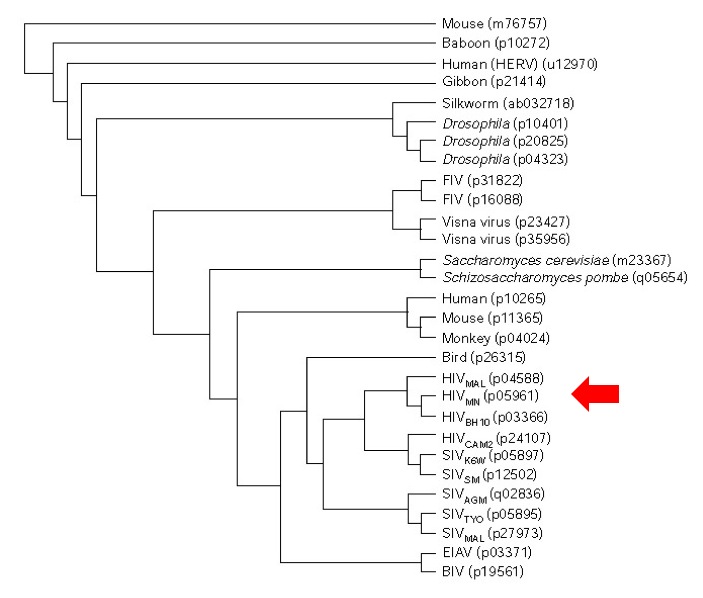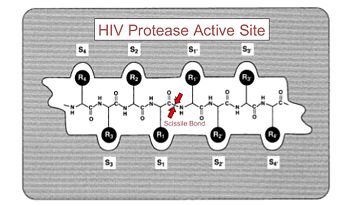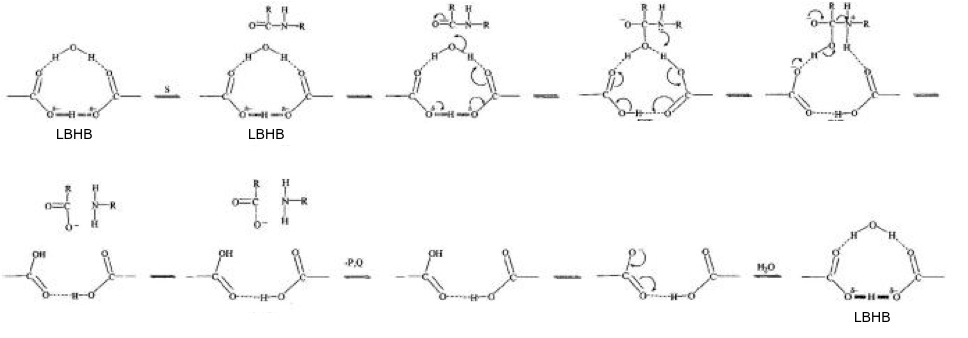User:Nicole Maille/Sandbox 1
From Proteopedia
| |||||||||
| 2nmz, resolution 0.97Å () | |||||||||
|---|---|---|---|---|---|---|---|---|---|
| Ligands: | , | ||||||||
| Gene: | gag (Human immunodeficiency virus 1) | ||||||||
| Activity: | HIV-1 retropepsin, with EC number 3.4.23.16 | ||||||||
| Related: | 2nmw, 2nmy, 2nnk, 2nnp | ||||||||
| |||||||||
| |||||||||
| Resources: | FirstGlance, OCA, RCSB, PDBsum | ||||||||
| Coordinates: | save as pdb, mmCIF, xml | ||||||||
Contents |
Introduction
HIV is a notoriously lethal retrovirus that is known to cause AIDS[1]. There currently is no cure or vaccine, but, scientists have discovered treatments that can slow progression of the HIV virus, thanks in large part to our understanding of the structure of HIV-1 protease (EC.3.4.23.16), seen here on the right in complex with a potent drug used for slowing the progression of HIV, (PDB entry 2nmz).
HIV-1 protease is a protein made by the HIV virus that is crucial to the virus's infectious capacity. The virus makes certain proteins that need to be cleaved, or cut, in order to transform into mature, fully-functional proteins that can allow the virus to infect new cells. HIV-1 protease is responsible for cleaving these nascent proteins into their mature form at a rate 10^10 faster than that of the uncatalyzed reaction in water[2].
Structure
Looking at the structure of HIV-1 protease, we see that the protein is composed of shown here in cartoon backbone representation to highlight secondary structure. Each subunit of the homodimer consists of a small 99 amino acid chain. The subunits come together in such as way as to , shown here in spacefilling representation to showcase the physical surface of the protein. The protein to be cleaved sits in this tunnel. In the middle of the tunnel is the of the protease: (residue numbers 25, 26, and 27 on one chain and 25', 26', and 27' on the second). act as the main catalytic residues in the active site and use a water molecule to help break the protein chain that binds in the tunnel. You may be wondering how a protein to be cleaved makes its way into the active-site tunnel to begin with -- after all, the tunnel does not seem so accessible. The key is the two flexible β-hairpin flaps on the top of the tunnel that can (large scene, takes a while to load) to allow proteins to enter the tunnel. A is also illuminating, as the change in the accessibility of the tunnel becomes more obvious. This movement of the flexible flaps is simulated by morphing between two crystal structures, the first being the native HIV-1 protease structure with no inhibitor bound (PDB entry 1hhp) and the second being the HIV-1 protease complexed with Saquinavir. As you can imagine, if an inhibitor is bound to the active site of HIV protease, other polyprotein precursors for HIV cannot bind, therefore, inhibiting the productions of mature proteins and ultimately the ability for these proteins to infect other cells.
Mechanism
HIV protease is classified as an aspartic protease. Evidence for this classification is listed below:
1) The Asp-Thr-Gly in the active site of HIV protease is highly conserved in aspartic protease enzymes[3].
2) Mutational analysis studies have shown that mutation of one of these essential Asp-25 groups to Asn, Thr, or Ala resulted in complete loss of proteolytic activity[4][5][6][7].
3) HIV protease is inhibited in vitro by pepstatin, a known inhibitor of aspartic proteases[5][6][8].
4) The 3-dimensional homodimeric structure is characteristic of aspartic proteases[9][10][11].
The Presence of a Low-Barrier Hydrogen Bond in the Active Site of HIV Protease
There has been much debate over the protonation state of Asp 25 and Asp 25'. Time-dependent kinetics of HIV protease with 1,2-epoxy-3-(4-nitrophenoxy)propane, a known aspartic protease inhibitor, from Meek et al. suggest that only one Asp is protonated in the active site of the enzyme[12]. However, theoretical calculations by Piana et al. indicated the presence of a low-barrier hydrogen bond (LBHB) between the two negatively charged oxygens of Asp 25 and Asp 25'[13]. Das et al. later determined that the inner oxygen atoms of the aspartates were 2.3 Â apart, supporting the LBHB prediction[14]. Recent computer simulation studies using HIV-1 protease have lead to the conclusion that the presence LBHB is more important for enhancing the rate of enzymatic reactions rather than the dynamic effects [2]. Northrop proposed a mechanism for aspartic proteases with the inclusion of a LBHB between the two inner carboxylate oxygen atoms of aspartate [15]. Analysis by Hunkapillar and Richards of the Asp pKas in H20 show that ΔpKa was much greater than zero [16], however, recent analyses by Northrop in D20 suggest that the pKas are 3.5 and 4.1 (ΔpKa = 0.6 units)[15].
Proposed mechanism by Northrop
Upon substrate binding, the two flap close, and E→ ES→E′S with the electrons flowing in a counterclockwise manner within the cycle. Moving two electrons clockwise forms a tetrahedral intermediate that is bound to the F' form of the enzyme. Subsequently, two electrons move clockwise around the cycle to generate the zwitterion intermediate which is bound to the monoprotonated G' form of the enzyme. Collapse of this zwitterion intermediate breaks the scissile bond, and leaves the enzyme in the F' form. The flaps open and product is released. The enzyme is then deprotonated and rehydrated, forming the initial E complex.
Evolutionary History
A phylogenic tree showing the relationships between selected retroviral proteases.

Inhibitors
Saquinavir was the the first protease inhibitor approved by the FDA for the treatment of HIV. It inhibits HIV-1 protease by , thus preventing the protease from cleaving any protein chains.
Other drugs used to treat patients infected with the HIV virus include Indinavir (PDB entry 1hsg), Ritonavir (PDB entry 1hxw), and Nelfinavir (PDB entry 1ohr).
References
- ↑ Gallo RC, Montagnier L. AIDS in 1988. Sci Am. 1988 Oct;259(4):41-8. PMID:3072672
- ↑ 2.0 2.1 Bjelic S, Aqvist J. Catalysis and linear free energy relationships in aspartic proteases. Biochemistry. 2006 Jun 27;45(25):7709-23. PMID:16784222 doi:10.1021/bi060131y
- ↑ Cairns J, Overbaugh J, Miller S. The origin of mutants. Nature. 1988 Sep 8;335(6186):142-5. PMID:3045565 doi:http://dx.doi.org/10.1038/335142a0
- ↑ Kohl NE, Emini EA, Schleif WA, Davis LJ, Heimbach JC, Dixon RA, Scolnick EM, Sigal IS. Active human immunodeficiency virus protease is required for viral infectivity. Proc Natl Acad Sci U S A. 1988 Jul;85(13):4686-90. PMID:3290901
- ↑ 5.0 5.1 Darke PL, Leu CT, Davis LJ, Heimbach JC, Diehl RE, Hill WS, Dixon RA, Sigal IS. Human immunodeficiency virus protease. Bacterial expression and characterization of the purified aspartic protease. J Biol Chem. 1989 Feb 5;264(4):2307-12. PMID:2644259
- ↑ 6.0 6.1 Blusch JH, Seelmeir S, von der Helm K. Molecular and enzymatic characterization of the porcine endogenous retrovirus protease. J Virol. 2002 Aug;76(15):7913-7. PMID:12097607
- ↑ Mous J, Heimer EP, Le Grice SF. Processing protease and reverse transcriptase from human immunodeficiency virus type I polyprotein in Escherichia coli. J Virol. 1988 Apr;62(4):1433-6. PMID:2450209
- ↑ Hansen J, Billich S, Schulze T, Sukrow S, Moelling K. Partial purification and substrate analysis of bacterially expressed HIV protease by means of monoclonal antibody. EMBO J. 1988 Jun;7(6):1785-91. PMID:3049075
- ↑ Navia MA, Fitzgerald PM, McKeever BM, Leu CT, Heimbach JC, Herber WK, Sigal IS, Darke PL, Springer JP. Three-dimensional structure of aspartyl protease from human immunodeficiency virus HIV-1. Nature. 1989 Feb 16;337(6208):615-20. PMID:2645523 doi:http://dx.doi.org/10.1038/337615a0
- ↑ Miller M, Schneider J, Sathyanarayana BK, Toth MV, Marshall GR, Clawson L, Selk L, Kent SB, Wlodawer A. Structure of complex of synthetic HIV-1 protease with a substrate-based inhibitor at 2.3 A resolution. Science. 1989 Dec 1;246(4934):1149-52. PMID:2686029
- ↑ Lapatto R, Blundell T, Hemmings A, Overington J, Wilderspin A, Wood S, Merson JR, Whittle PJ, Danley DE, Geoghegan KF, et al.. X-ray analysis of HIV-1 proteinase at 2.7 A resolution confirms structural homology among retroviral enzymes. Nature. 1989 Nov 16;342(6247):299-302. PMID:2682266 doi:http://dx.doi.org/10.1038/342299a0
- ↑ Meek TD, Dayton BD, Metcalf BW, Dreyer GB, Strickler JE, Gorniak JG, Rosenberg M, Moore ML, Magaard VW, Debouck C. Human immunodeficiency virus 1 protease expressed in Escherichia coli behaves as a dimeric aspartic protease. Proc Natl Acad Sci U S A. 1989 Mar;86(6):1841-5. PMID:2648384
- ↑ Piana S, Carloni P. Conformational flexibility of the catalytic Asp dyad in HIV-1 protease: An ab initio study on the free enzyme. Proteins. 2000 Apr 1;39(1):26-36. PMID:10737924
- ↑ Das A, Prashar V, Mahale S, Serre L, Ferrer JL, Hosur MV. Crystal structure of HIV-1 protease in situ product complex and observation of a low-barrier hydrogen bond between catalytic aspartates. Proc Natl Acad Sci U S A. 2006 Dec 5;103(49):18464-9. Epub 2006 Nov 20. PMID:17116869
- ↑ 15.0 15.1 Northrop DB. Follow the protons: a low-barrier hydrogen bond unifies the mechanisms of the aspartic proteases. Acc Chem Res. 2001 Oct;34(10):790-7. PMID:11601963
- ↑ Hunkapiller MW, Richards JH. Studies on the catalytic mechanism of pepsin using a new synthetic substrate. Biochemistry. 1972 Jul 18;11(15):2829-39. PMID:4557517
- Atomic resolution crystal structures of HIV-1 protease and mutants V82A and I84V with saquinavir., Tie Y, Kovalevsky AY, Boross P, Wang YF, Ghosh AK, Tozser J, Harrison RW, Weber IT, Proteins. 2007 Apr 1;67(1):232-42. PMID:17243183
- The three-dimensional structure of the aspartyl protease from the HIV-1 isolate BRU., Spinelli S, Liu QZ, Alzari PM, Hirel PH, Poljak RJ, Biochimie. 1991 Nov;73(11):1391-6. PMID:1799632
Links
- Indinavir bound to HIV-1 protease 1hsg
- Nelfinavir bound to HIV-1 protease 1ohr
- Ritonavir bound to HIV protease 1hxw
- Simian immunodeficiency virus (SIV) protease 1tcw
- SIV protease mutant 2sam
- Feline immunodeficiency virus (FIV) protease 5fiv
- HIV-2 protease without inhibitor 1hsi
- HIV-2 protease with renin inhibitor 2phv
- HIV-1 Protease featured in David S. Goodsell's Molecule of the Month
- HIV-1 Protease in Wikipedia



